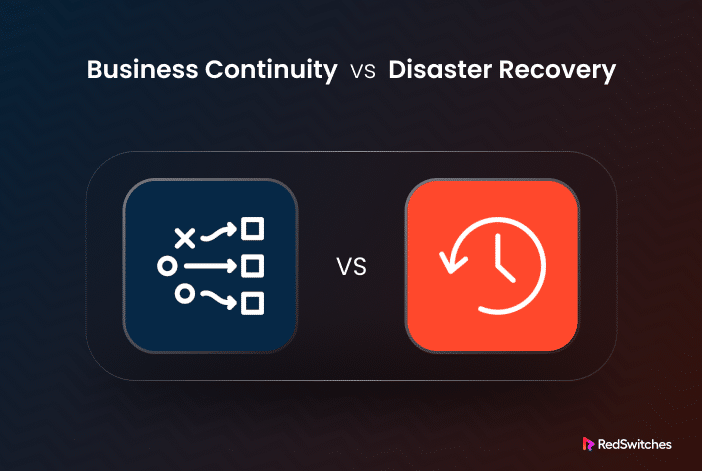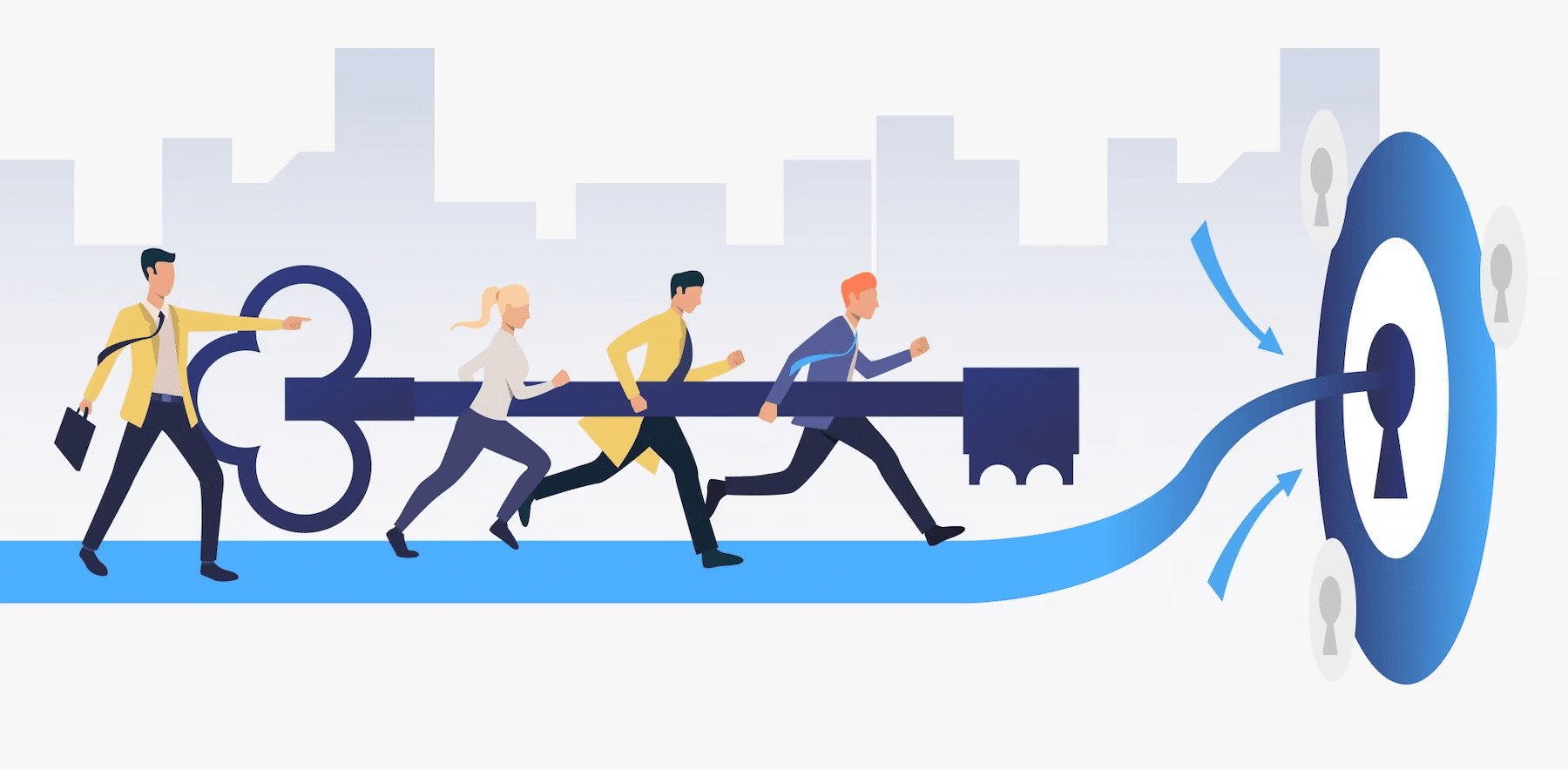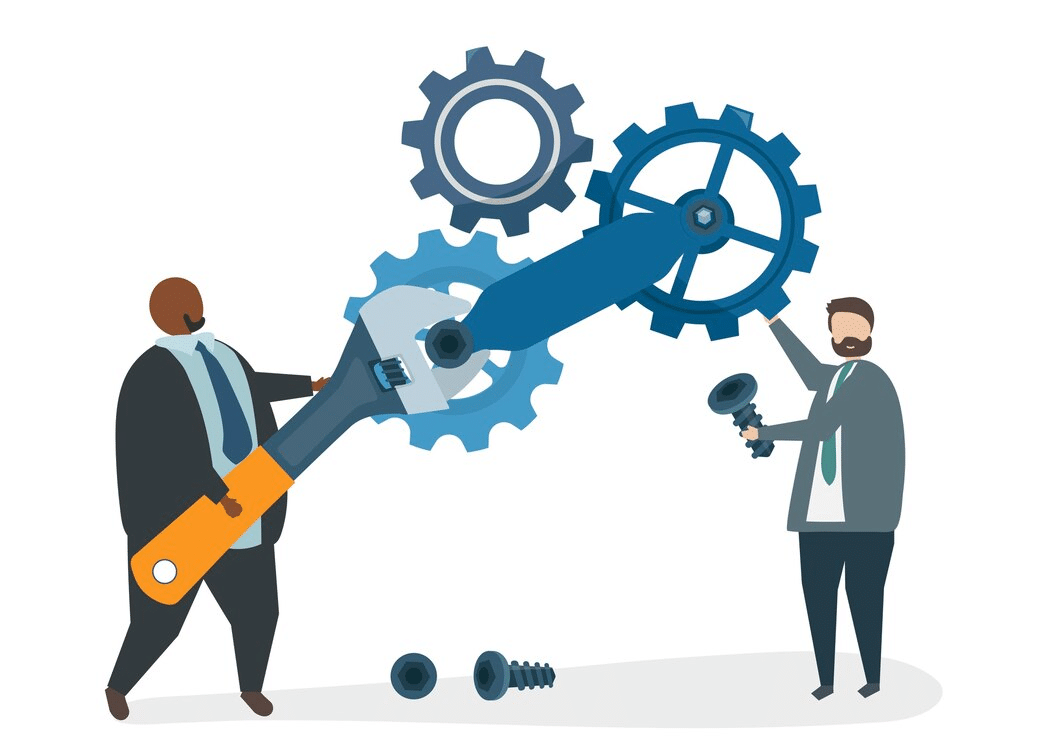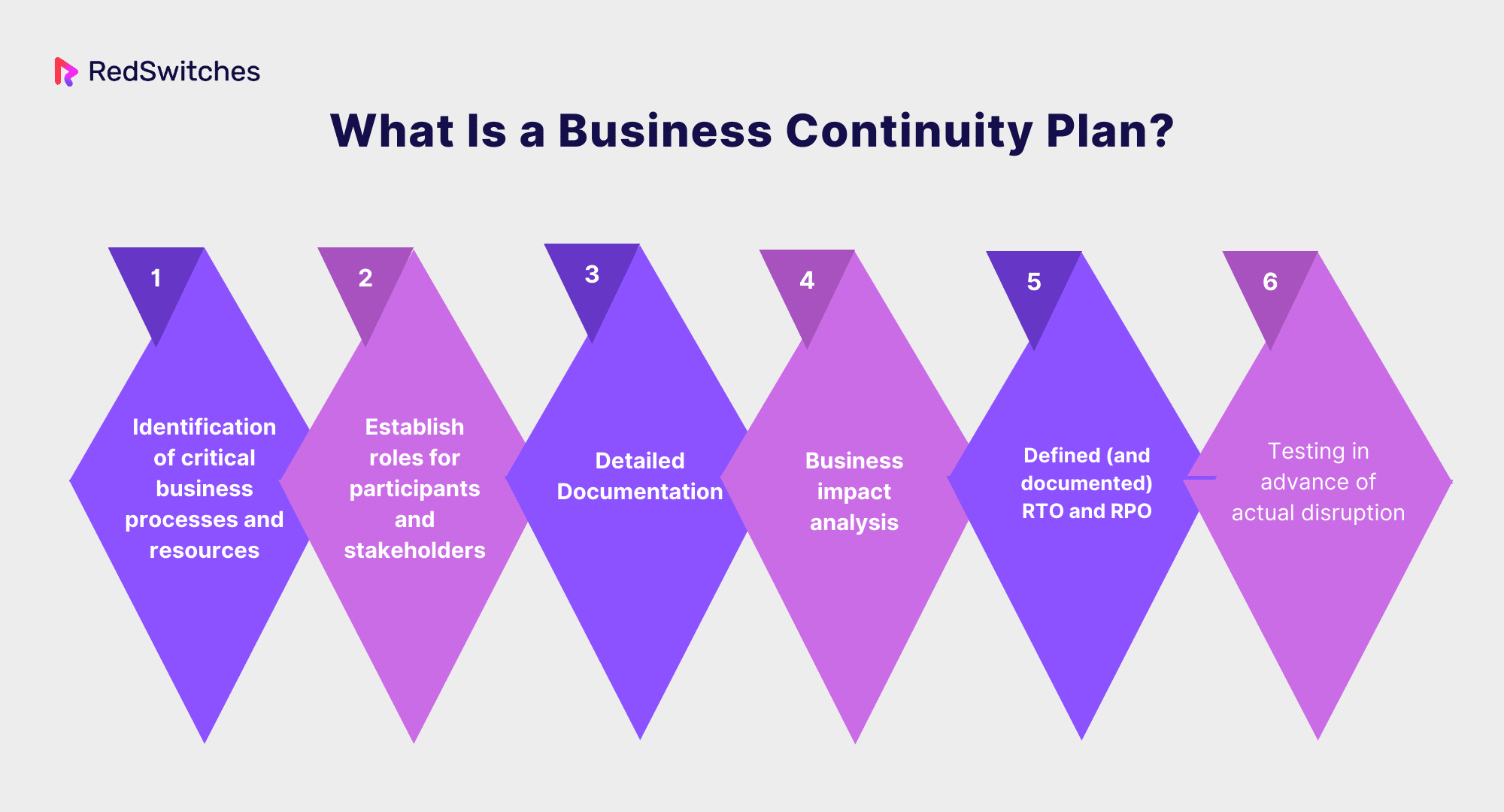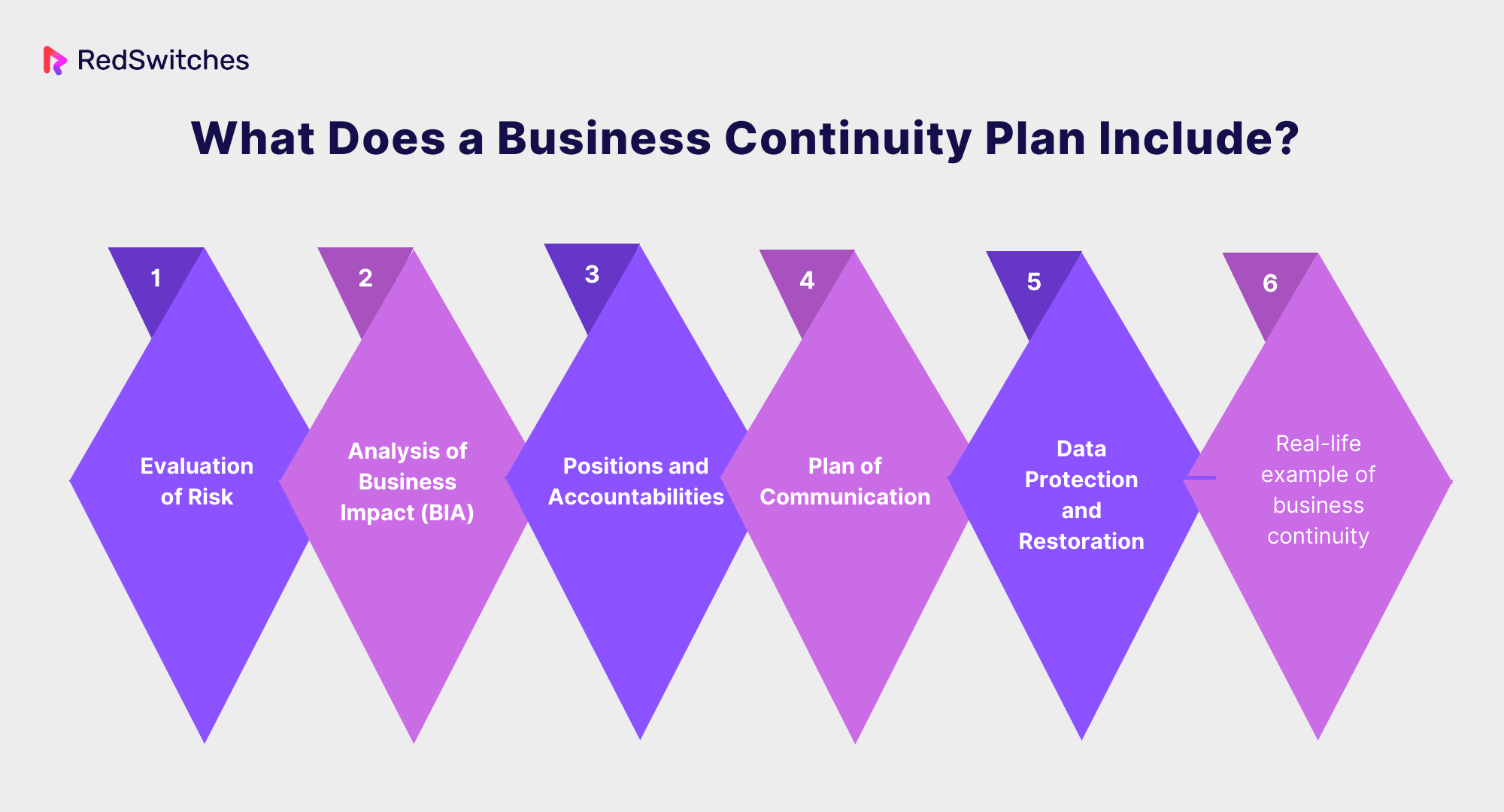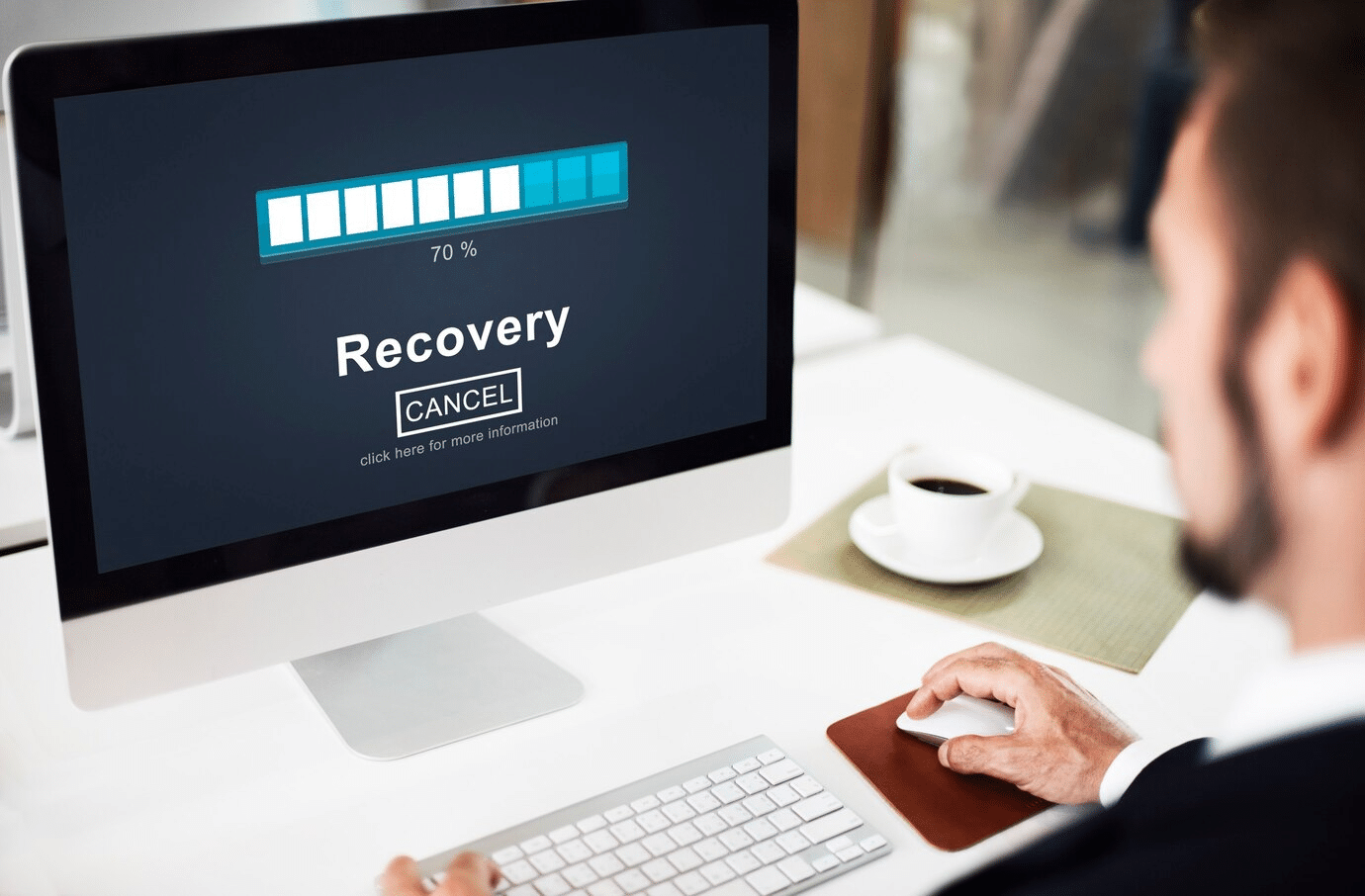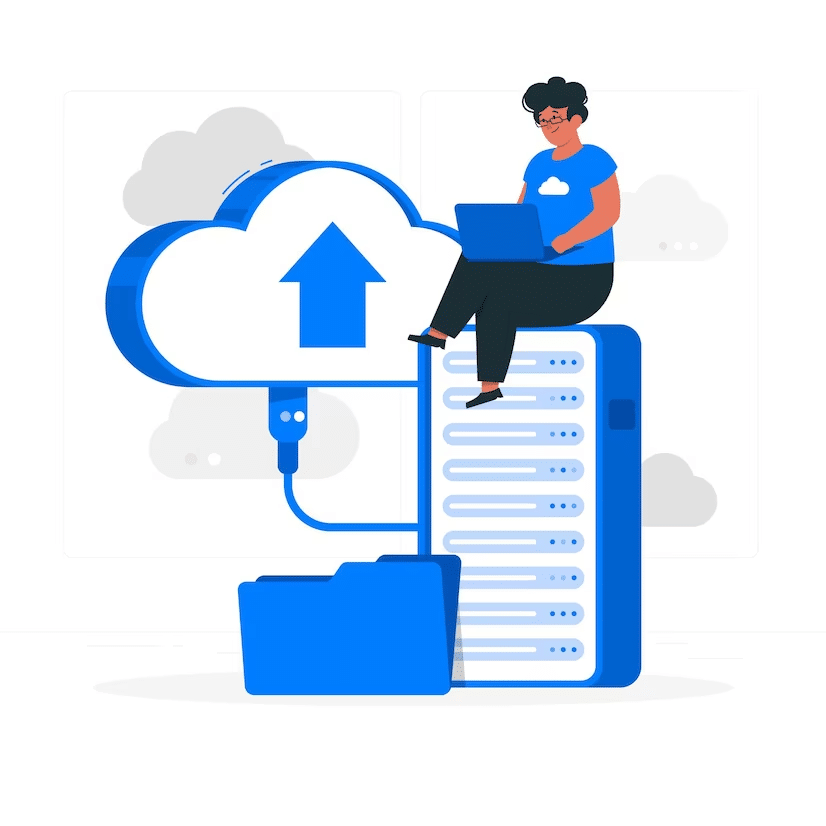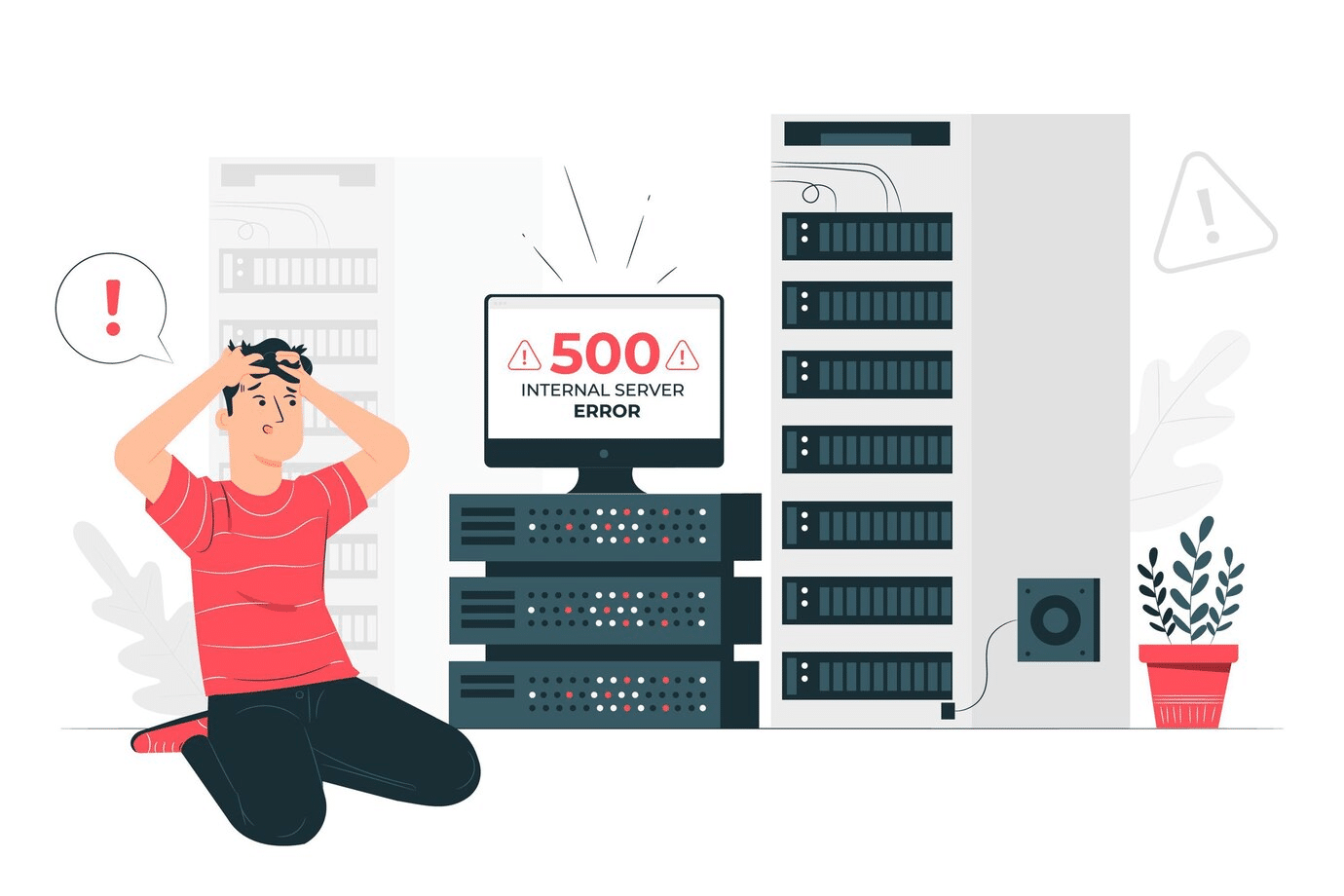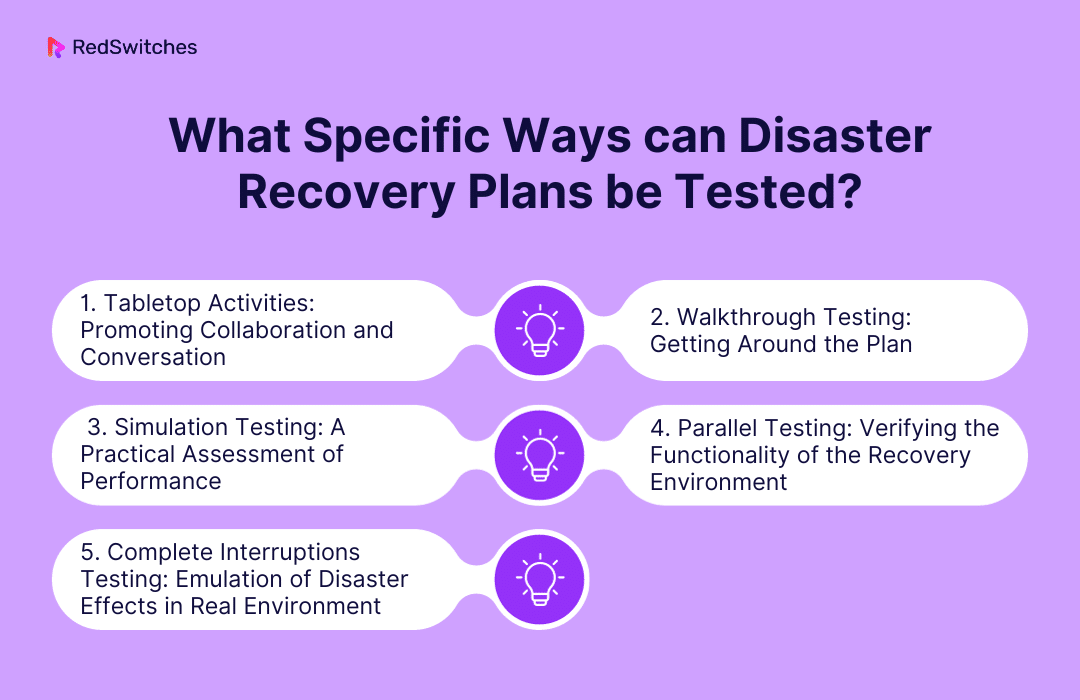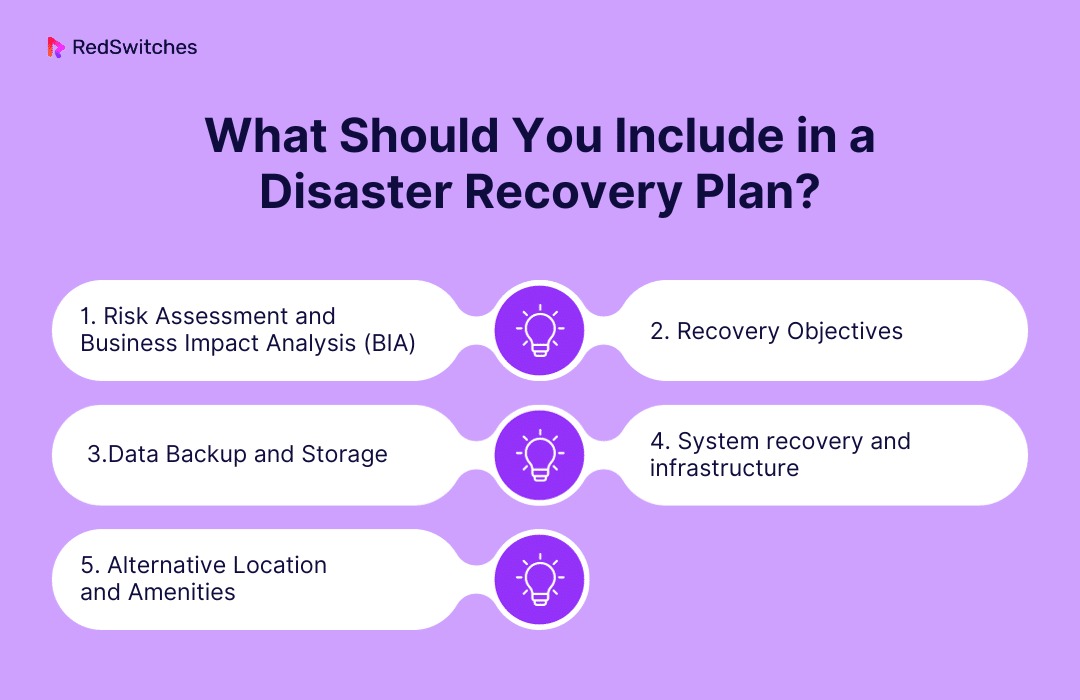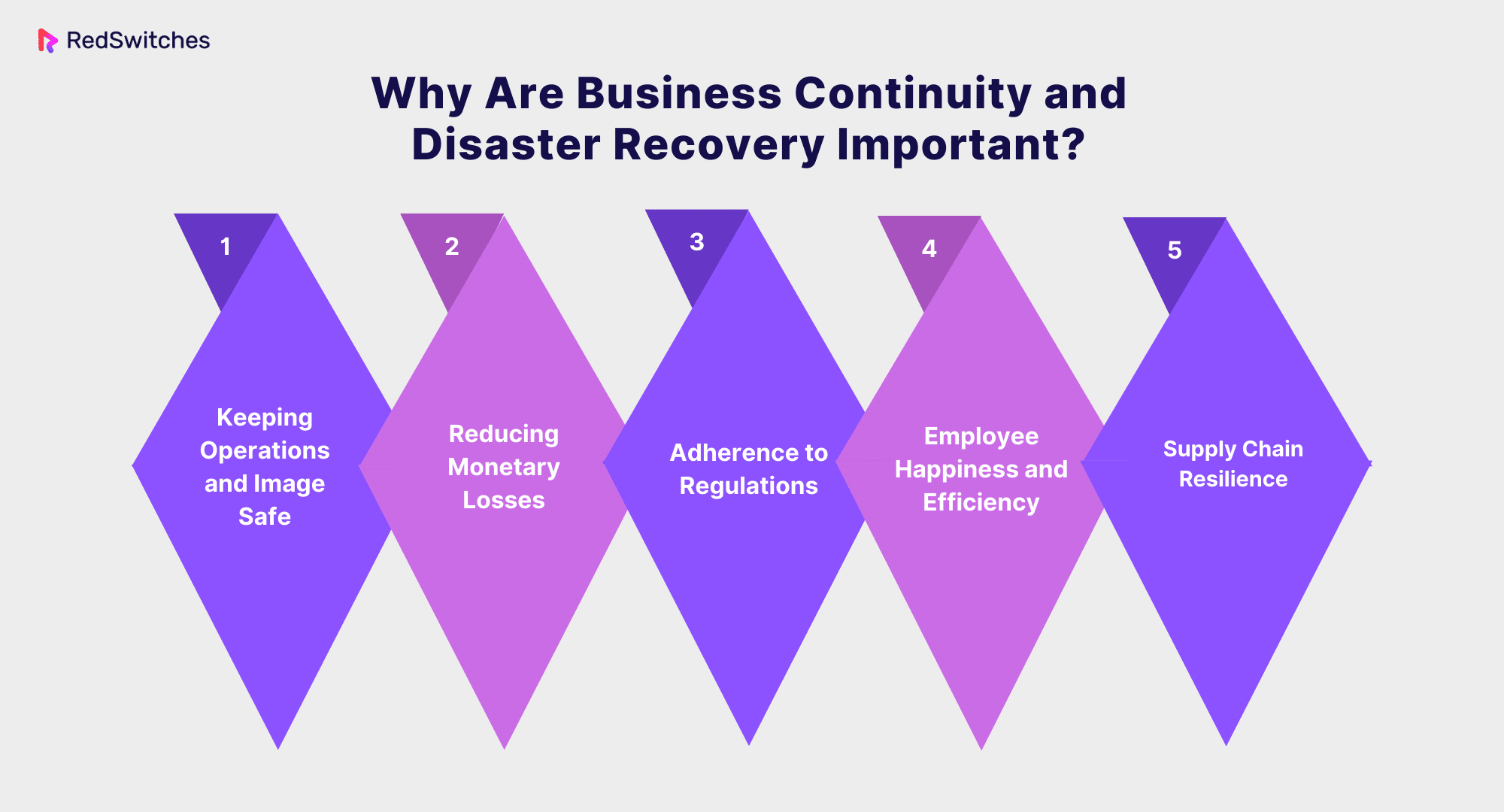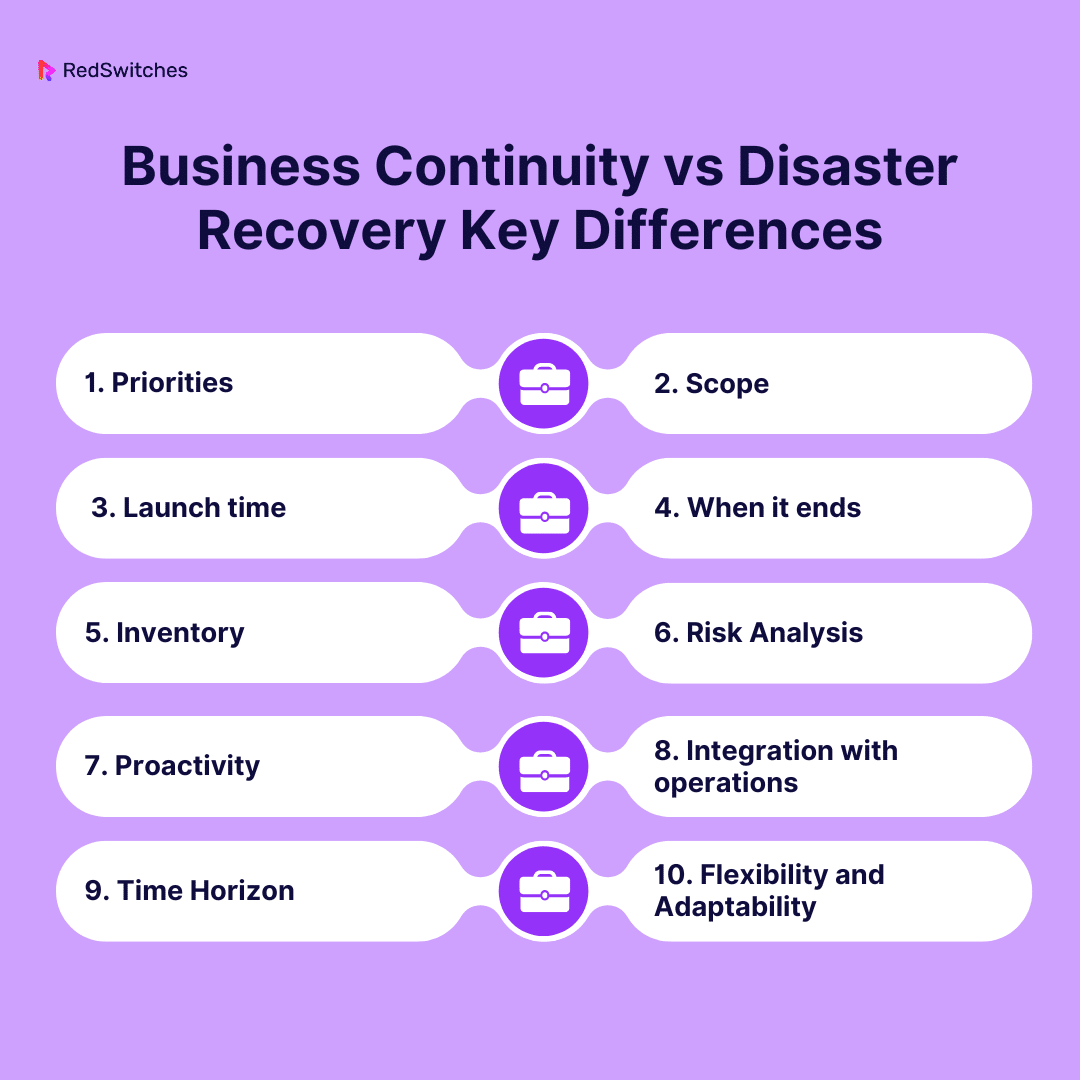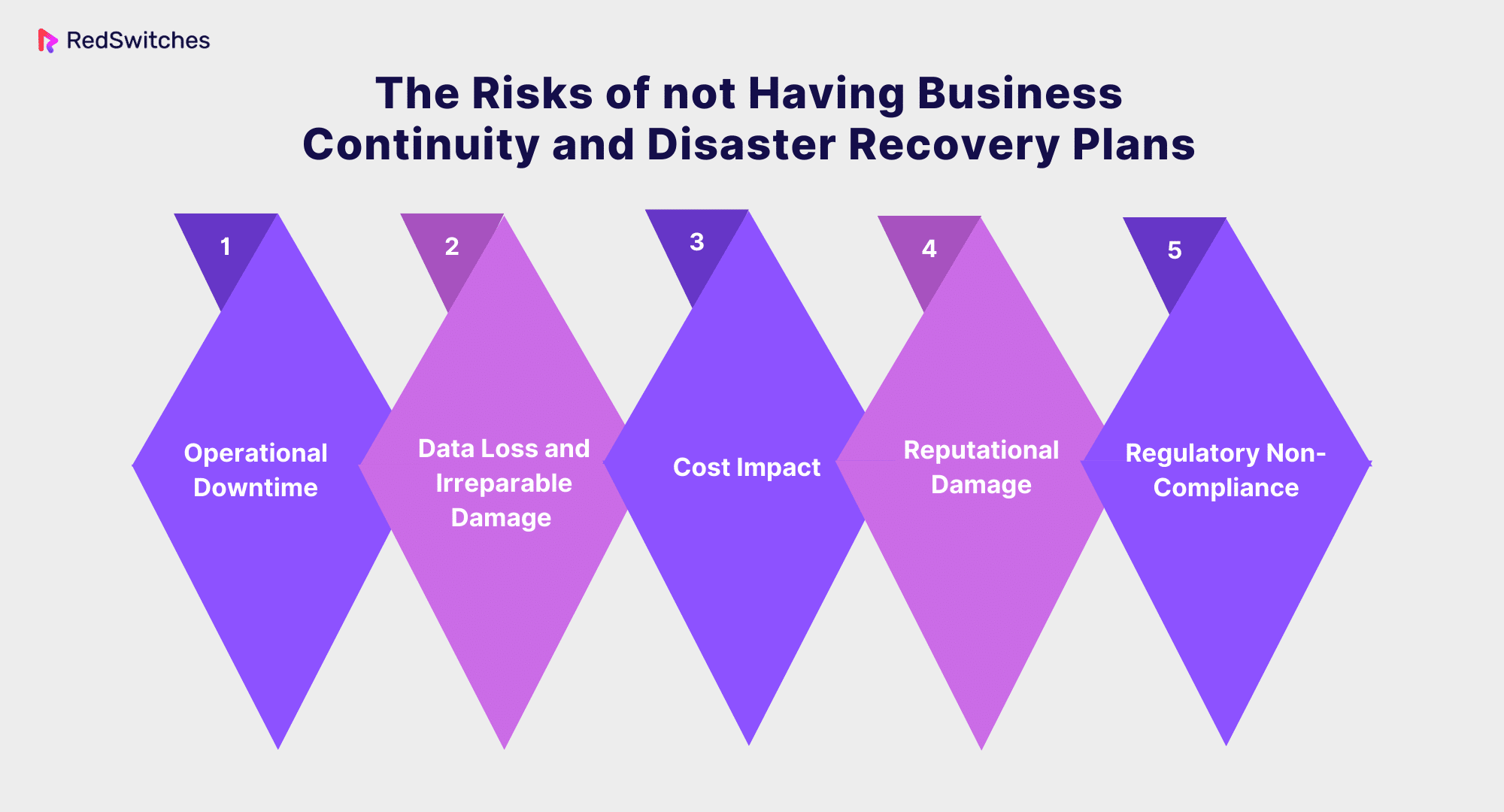Key Takeaways
- Business continuity (BC) ensures ongoing operations during disruptions, focusing on maintaining critical functions and quick recovery.
- Disaster recovery (DR) concentrates on restoring IT systems and data post-disaster, aiming to minimize downtime and data loss.
- BC plans are comprehensive, covering personnel, processes, and infrastructure, while DR plans are more technically focused on IT assets.
- Implementing BC and DR plans provides a holistic approach to organizational resilience, addressing operational and technological aspects.
- Lack of BC and DR plans risks operational downtime, data loss, financial impacts, reputational damage, and regulatory non-compliance.
- The synergy between BC and DR plans enhances an organization’s ability to respond to and recover from disruptions, safeguarding against a wide range of risks.
Organizations must balance recovery and resilience. The business world is unpredictable. Each move can lead to success or unexpected challenges.
Business continuity and disaster recovery are related but different. They are important for organizations to prepare for catastrophes. Business continuity focuses on keeping the business operational during a disaster. On the other hand, disaster recovery focuses on restoring data access and IT infrastructure after a disaster.
Business continuity planning is the foundation of a business’s disaster planning. It should come first, followed by disaster recovery planning. Both business continuity and disaster recovery planning are necessary. But, an organization’s needs will determine which is more important.
A response plan is a playbook for assessing and handling incidents. It may trigger a business continuity plan or disaster recovery plan. This article will discuss the key difference between business continuity vs disaster recovery.
Table Of Contents
- Key Takeaways
- What is Business Continuity?
- What is a Business Continuity Plan?
- What Does a Business Continuity Plan Include?
- What is Disaster Recovery?
- What is a Disaster Recovery Plan?
- Why Are Business Continuity and Disaster Recovery Important?
- Why is Communication Critical in Disaster Situations?
- Key Differences of Business Continuity vs Disaster Recovery
- Business Continuity vs Disaster Recovery: Priorities
- Business Continuity vs Disaster Recovery: Scope
- Business Continuity vs Disaster Recovery: Launch Time
- Business Continuity vs Disaster Recovery: When It Ends
- Business Continuity vs Disaster Recovery: Inventory
- Business Continuity vs Disaster Recovery: Risk Analysis
- Business Continuity vs Disaster Recovery: Proactivity
- Business Continuity vs Disaster Recovery: Integration With Operations
- Business Continuity vs Disaster Recovery: Time Horizon
- Business Continuity vs Disaster Recovery: Flexibility and Adaptability
- How Do Business Continuity and Disaster Recovery Work Together?
- Risks of Not Having Business Continuity and Disaster Recovery Plans
- Conclusion
- FAQs
What is Business Continuity?
Credits: Freepik
An organization must carry out key business operations during and after a crisis. This is known as business continuity. It aims to prevent disruptions to critical services. It also aims to quickly and smoothly restore day-to-day operations to the organization. Simply put, business continuity planning sets up risk management policies and procedures.
Keeping core activities going and recovering quickly are the most basic needs for company continuity in a crisis. The plan considers unpredictable events and risks. These include supply chain disruptions, cyberattacks, disease outbreaks, pandemics, fires, and other dangers.
For most organizations, except the largest ones, keeping all operations running during a crisis may not be realistic. Hence, business continuity strategies are deemed crucial for organizations of all sizes.
Many experts say the first step is to identify critical operations. Then, allocate funds for them. After allocating funds, admins can implement failover strategies for the key components.
Disc mirroring is a technology that helps organizations keep up-to-date copies of their data. The copies are at the main data center and distant locations. This ensures data protection, allowing continued data access even if one location is disabled.
What is a Business Continuity Plan?
Credits: Freepik
A business continuity plan, or BCP, is a mechanism to prevent and recover from possible organizational risks. During a crisis, the plan ensures that people and property are safeguarded and can promptly resume operations.
BCP is essential to an organization’s risk management. It identifies all potential hazards that could impact the business’s operations. Cyberattacks and natural catastrophes, like fires, floods, or weather incidents, might pose risks.
BCPs are crucial to any business. They safeguard against risks and disruptions. These can lead to reduced profits from lost revenue and higher costs. Furthermore, businesses cannot just rely on insurance. It often doesn’t cover all expenses and lost income. This is especially true when customers switch to competitors. BCPs are made before to address these challenges well. They include input from key people and stakeholders. This ensures a complete and effective plan.
Identification of Critical Business Processes and Resources
An exact inventory of the company’s vital functions is key. It includes its most important resources and procedures. It is the foundation of any successful business continuity plan. The first stage acts as a compass. It helps organizations identify, prioritize, and protect the key elements that keep the business smooth.
Establish Roles for Participants and Stakeholders
A BCP assigns roles to participants and stakeholders. It turns chaos into action. This guarantees everyone knows what to do when difficulty arises. It encourages a calm and coordinated response to disturbances.
Detailed Documentation
A BCP depends on thorough documentation, like how a planned routine necessitates exact procedures. This contains the general strategy and the specifics, providing a script that viewers can adhere to if the show takes an unexpected turn.
Business Impact Analysis
A BCP depends on thorough documentation. It’s like how a planned routine needs exact procedures. This includes the overall plan and specific details, offering a guide for people to follow if things don’t go as planned.
Defined (and documented) RTO and RPO
In the business world, time is of the essence. The RTO and RPO set how fast the show must go and how much data loss is allowed. They are defined and documented in a BCP.
Testing in Advance of Actual Disruption
Just like a performance needs rehearsals to be perfect, a BCP is tested before any actual disruptions happen. The runs make sure everyone is ready to act fast and well. They cut delays and ensure the team’s resilience is praised.
Here’s a must-read article on server downtime, its causes, effects, and how to prevent it.
What Does a Business Continuity Plan Include?
Credits: Freepik
A Business Continuity Plan (BCP) ensures business operations continue during unplanned disruptions. It starts with a Business Impact Analysis (BIA). The BIA rates the harm of disruption to the business. It also finds critical operations and functions. The plan also includes a thorough Risk Assessment. It will evaluate the chance and impact of various risks and disruptions to the business.
A key part of the BCP is identifying Recovery Strategies. These strategies outline how the business will continue critical operations after an incident. These strategies might involve alternative methods or locations for conducting business.
The BCP also outlines the Incident Management Plan. It sets the roles, duties, and steps for managing an incident. This includes plans to talk to stakeholders and emergency services.
The Development of Recovery Plans for key business areas such as IT systems, data, and customer service is also integral. These plans provide specific instructions for returning to normal operations after the disruption.
Finally, the BCP includes regular Testing and Maintenance procedures to ensure the plan is effective and current. This involves periodic reviews and drills to simulate disruptions. They allow the organization to refine its response strategies and ensure all staff know their roles in an emergency.
A Business Continuity Plan is a full approach. It ensures that a business can quickly recover from disruptions. It minimizes loss and ensures the continuity of critical operations.
Evaluation of Risk
A Business Continuity Plan (BCP) starts with a detailed investigation. It aims to find threats and risks that might interfere with business. These events are natural catastrophes, cyberattacks, and broken supply chains. They are unanticipated.
This means fully evaluating many risk categories. These include supply chain disruptions, cyberattacks, natural disasters, and unforeseen events. The organization must address these risks proactively. The goal is to find potential points of failure and vulnerabilities in the business.
Analysis of Business Impact (BIA)
A Business Impact Analysis (BIA) determines and ranks the vital business processes and resources. This entails assessing how disruptions would affect many corporate areas. These include IT, finance, customer service, and production. Organizations can prioritize their efforts and resources. This is to ensure the continuity of their most essential operations. They can do this by estimating the likely results of disruptions.
Positions and Accountabilities
In a crisis, it’s critical to establish precisely each person’s and team’s duties and responsibilities. This guarantees that all individuals know their roles and obligations in carrying out the BCP. Such roles include recovery teams, emergency response teams, and communication coordinators.
The BCP guarantees everyone knows their part. It does this by clearly defining roles and responsibilities. This encourages a coordinated and effective reaction to the disaster.
Plan of Communication
A Business Continuity Plan (BCP) describes communication tactics for external and internal stakeholders. It has procedures for informing staff members, clients, vendors, and the press. Managing the public’s view of the organization in a crisis requires clear communication.
It describes how to notify employees, clients, vendors, and the media about the problem and the steps being taken to fix it. Timely and open communication helps with internal crisis management. It fosters trust and confidence outside the company.
Here’s how Hinduja Tech gets its ideal data management service provider.
Data Protection and Restoration
Two crucial indicators in a BCP are the Recovery Time Objective (RTO) and the Recovery Point Objective (RPO). RPO establishes the maximum permitted data loss, whereas RTO sets the permissible downtime for each key process. These parameters guide the creation of backup and recovery solutions.
RTO sets acceptable downtime for each critical process. It guides the organization’s strategy for quickly resuming operations. These specs are key for making backup and recovery plans. They must fit the company’s tolerance for downtime and data loss.
Real-life Example of Business Continuity
A South Carolina-based IT company’s office building that housed servers for 200 clients was struck by lightning back in 2013. The business’s infrastructure suffered significant damage. The equipment was destroyed. The cables melted. The computer hardware burned. The office became unusable.
Five years back, the company had put business continuity plans into place. These plans included moving its client servers to a remote data server. The server maintained continuous backups. Customers had no issues. But, staff had to move into temporary office space.
In our business continuity vs. disaster recovery battle, we will discuss disaster recovery. We will highlight a real-life example.
What is Disaster Recovery?
Credits: Freepik
Disaster recovery is the business’s plan for reacting to a disaster or other significant event. This can include events potentially interfering with the business’s operations, such as fires, natural disasters, cyberattacks, terrorism, accidents, active shooters, and other crises. Plans for disaster recovery assist in directing an organization’s response to an incident or occurrence and offer direction on safely resuming regular activities.
What is a Disaster Recovery Plan?
Credits: Freepik
An organization’s methods, procedures, and tools for recovering and restoring its IT infrastructure, data, and operations during a disaster or disruptive occurrence are outlined in a Disaster Recovery Plan (DRP), a systematic and comprehensive strategy. A disaster recovery plan is intended to reduce data loss and downtime while facilitating the quick restoration of vital business operations following an unfavorable incident.
The plan comprises actions to lessen the impact of a calamity so that the company may swiftly resume mission-critical operations or carry on with business as usual. A DRP typically includes an investigation of the demands for continuity and business processes. An organization often conducts a risk analysis (RA) and business impact analysis (BIA) to set recovery targets before creating a comprehensive strategy.
As cybercrime and security breaches become more complex, an organization should establish its data recovery and protection procedures. Reducing downtime and minimizing financial and reputational consequences are possible with prompt issue handling. DRPs offer a defined recovery plan and assist organizations in meeting compliance obligations.
What Specific Ways Can Disaster Recovery Plans Be Tested?
Credits: Freepik
Let’s look at the ways a disaster recovery plan can be tested before moving to our ultimate battle of business continuity plan vs disaster recovery plan.
Tabletop Activities: Promoting Collaboration and Conversation
Tabletop exercises commonly test a Disaster Recovery Plan’s (DRP) efficacy. In this exercise, key staff members work together to go through a pretend disaster situation. The focus is on checking how well the Disaster Recovery Plan (DRP) is coordinated, how decisions are made, and how clearly everyone communicates. Even though these exercises don’t include actual recovery actions, they are crucial for testing the plan and how well everyone talks to each other.
Walkthrough Testing: Getting Around the Plan
Participants in walkthrough testing physically go through the DRP’s processes without carrying out any recovery operations. This approach helps see any problems with plan processes and assists staff members in becoming acquainted with their responsibilities.
Simulation Testing: A Practical Assessment of Performance
Simulation testing is a more proactive method that entails a controlled simulation of a crisis scenario. This could involve performing recovery processes and shutting down the system entirely or partially. By offering a practical evaluation of the DRP’s efficacy, this approach helps companies pinpoint areas where their recovery procedures fall short.
However, meticulous planning is necessary to avoid interfering with current operations and possibly creating downtime during testing.
Parallel Testing: Verifying the Functionality of the Recovery Environment
Running duplicate systems following production systems is known as parallel testing, and it is used to verify that the recovery environment is functioning correctly. Organizations can use this method to evaluate the recovery environment’s viability without interfering with regular business operations.
Parallel testing, while offering a thorough assessment, requires more resources to maintain duplicate systems and may pose synchronization challenges.
Complete Interruptions Testing: Emulation of Disaster Effects in Real Environment
Full-interruption testing, considered the most realistic test, entails momentarily stopping production systems and depending on the recovery environment to continue business operations.
This approach comprehensively analyzes the DRP’s capacity to restore essential features. To minimize the impact on existing operations, however, meticulous preparation is necessary due to the high level of risk involved.
Also, check out how object oriented databases add value to business operations.
What Should You Include in a Disaster Recovery Plan?
Before moving towards our core part of the blog i.e. business continuity vs disaster recovery, we will discuss steps to be included in a disaster recovery plan.
Risk Assessment and Business Impact Analysis (BIA)
- Identify potential threats and vulnerabilities through a comprehensive risk assessment.
- Conduct a Business Impact Analysis (BIA) to understand the criticality of different business processes and their potential disruption consequences.
Recovery Objectives
- Define specific Recovery Time Objectives (RTO) and Recovery Point Objectives (RPO) for each critical system and business process.
- Determine the maximum acceptable downtime and allowable data loss to guide recovery efforts.
Data Backup and Storage
- Develop a robust data backup strategy, including regular and secure backups of critical data.
- Specify backup methods, frequency, storage locations (onsite, offsite, or cloud), and encryption protocols.
System Recovery and Infrastructure
- Describe the recovery steps of servers, networks, hardware, and IT infrastructure.
- Establish procedures for repairing or restoring systems, setting up networks, and guaranteeing the availability of software and apps.
Alternative Location and Amenities
- Determine and set up backup locations or facilities where business operations can continue in a calamity.
- Indicate the kind of alternative (warm, cool, or hot) locations based on the need for recuperation and financial constraints.
Why Are Business Continuity and Disaster Recovery Important?
In this section, we will discuss five reasons behind the importance of BC and DR in our business continuity vs disaster recovery debate.
Keep Operations and Image Safe
Business Continuity (BC): Plans for BC are designed to maintain critical operations during and after disruptions. By identifying essential procedures and assets, establishments can guarantee that they maintain customer service, fulfill obligations, and safeguard their standing amongst obstacles.
This proactive strategy protects operations and upholds stakeholders’ and clients’ confidence.
Disaster Recovery: DR aims to quickly restore data and IT systems following a calamity. This is essential for reducing downtime, guaranteeing company continuity, and shielding an organization’s brand from long-term harm. The capacity to bounce back from setbacks quickly builds client trust and solidifies the company’s legitimacy.
Reduce Monetary Losses
Business Continuity: BC plans aim to reduce the financial impact of disruptions by predicting possible risks and taking steps to prevent them. By keeping the organization financially stable and cutting down on lost income, these plans ensure that operations can continue even during a natural disaster, cyberattack, or other unexpected events.
Disaster Recovery: Quick IT systems and data recovery are essential to minimize the financial losses from downtime. Plans for disaster recovery (DR) ensure that businesses can quickly restart vital operations, preventing revenue loss and the financial consequences that long-term disruptions can have.
Adherence to Regulations
Business Continuity (BC): Regulations governing numerous industries demand creating BC strategies. In addition to being required by law, following these requirements shows an organization’s dedication to ethical and durable business operations.
Disaster Recovery: Organisations must frequently implement data recovery and business continuity plans to comply with data protection laws. Respecting these guidelines promotes confidence with clients and business associates by strengthening data security and privacy and preventing legal repercussions.
Employee Happiness and Efficiency
Business Continuity: BC plans consider the security and welfare of employees in times of emergency. This covers provisions for working remotely, alternate workspaces, and communication tactics that inform and engage staff members and boost productivity overall.
Disaster Recovery: Employees can resume work effectively if IT systems are quickly restored. The availability of essential tools and systems promotes efficiency, reduces interruptions to work, and boosts staff morale during challenging circumstances.
Supply Chain Resilience
Business Continuity: (BC) plans handle supply chain dependencies by going beyond the confines of the company. Organizations safeguard the resilience of their supply chain by identifying essential suppliers and developing backup sources, preventing disruptions that could otherwise have a cascading effect on operations.
Disaster Recovery: By guaranteeing the quick recovery of systems that enable coordination and communication with suppliers, DR plans take into account the effects of disruptions on the supply chain. This allows businesses to continue acquiring and distributing goods and services.
This is our ultimate guide to dropshipping and how it works and beyond.
Why is Communication Critical in Disaster Situations?
After the debate on why business continuity and disaster recovery are necessary, we will now discuss the importance of communication in disaster situations.
Credits: Freepik
Educating staff members as soon as possible during a crisis in your company is critical. Employees must receive regular updates from you that are pertinent, clear, and factual. You should also inform them about any directions they need to follow. You should keep your team informed as circumstances change.
Rumors and misleading information may spread if you don’t tell your staff. This may cause misunderstandings and errors and possibly make the issue worse. One of the most effective ways to swiftly notify every employee is by utilizing an emergency alert system or IT alerting software. For instance, DeskAlerts.
DeskAlerts integrates the two features. It will allow you to communicate urgently and in an unignoring manner with thousands of employees at once. No matter where an employee works—at home, at the office, on the go, or in a non-desk role—you can reach them.
To ensure your messages are received, the system employs some communication channels, such as push notifications on mobile devices, desktop tickers, pop-up warnings, and digital signs.
Real-life Example of Business Continuity
A major operational catastrophe befell Delta Air Lines in August 2016, when a power failure at its primary data center in Atlanta resulted in a global flying ban and severe disruptions. Nonetheless, Delta’s comprehensive disaster recovery plan was essential in reducing the effects of this IT disruption.
The airline quickly moved operations to a different data center and turned on backup systems. This calculated action reduced the outage length and facilitated a quicker recovery by guaranteeing the restoration of vital IT systems.
A key component of Delta’s effective disaster recovery response was its dedication to open and honest communication. The airline provided real-time updates on flight statuses, alternate travel arrangements, and the status of recovery activities through various platforms, including social media and its official website.
During the crisis, managing passenger expectations and preserving confidence were primarily made possible by this prompt and unambiguous communication. Delta’s post-disaster recovery initiatives went beyond technology to include staff mobilization. The airline’s personnel were instrumental in overseeing the logistics, assisting passengers, and executing backup plans. This cooperative effort showed how crucial it is to have a well-organized and prepared team while overcoming obstacles brought on by a disruptive incident.
Most importantly, Delta Air Lines thoroughly examined the efficiency of its disaster recovery plans and the IT outage. Using the lessons learned from this occurrence, it developed a new disaster recovery plan that prioritizes resilience in the face of unforeseen interruptions and a commitment to ongoing development.
This case study highlights the significance of proactive disaster recovery planning and its pivotal function in upholding operational continuity and customer confidence under challenging conditions.
Key Differences of Business Continuity vs Disaster Recovery
Finally, we have arrived at the core part of our blog, where we will explain the key differences in the business continuity vs disaster recovery debate.
Business Continuity vs Disaster Recovery: Priorities
Our first point of difference in the business continuity vs disaster recovery debate is their priorities.
Business Continuity
During and after an interruption, business continuity plans prioritize the smooth continuation of critical business operations. Maintaining total organizational resilience, which includes reputation management, workforce continuity, and customer service, is the primary priority. BC plans ensure that vital activities go forward despite outside obstacles.
Disaster Recovery
On the other hand, following a calamity, disaster recovery plans prioritize quickly restoring IT systems and data. Reducing downtime and data loss is the main priority, with a focus on crucial technology infrastructure recovery.
Disaster recovery (DR) plans outline specific steps and approaches to speed up the recovery of networks, servers, databases, and other IT assets. Technological disaster recovery (DR) priorities are crucial because they guarantee that organizations quickly restore the capability required for critical business operations.
Business Continuity vs Disaster Recovery: Scope
In this differential section of the business continuity vs disaster recovery argument, we will compare the scope of both.
Business Continuity
Plans for Business Continuity (BC) cover a wide range of topics and are designed to ensure an organization is resilient in all respects. BC is primarily concerned with keeping vital business operations running during and after an interruption. This requires a multifaceted strategy involving people, procedures, technology, and facilities. Workforce continuity, customer service, reputation management, and the organization’s general operational health are all covered by BC plans.
Disaster Recovery
On the other hand, Disaster Recovery (DR) plans focus primarily on restoring IT systems and data, with a more narrowly defined scope. DR’s primary goal is to reduce downtime and data loss during a disaster, emphasizing the technological infrastructure supporting vital business operations.
DR’s scope is intrinsically technical to quickly return technological systems to pre-established working levels. The recovery of IT components essential to maintaining business operations is the primary focus of disaster recovery (DR), even though it is linked to larger organizational resilience initiatives.
Business Continuity vs Disaster Recovery: Launch Time
Let us compare the launch time of both concerning the business continuity vs disaster recovery battle.
Business Continuity
Plans for Business Continuity (BC) are initiated promptly during a disruption, demonstrating BC’s proactive character. BC has a quick launch timeline that includes the implementation of pre-established procedures for worker migration, communication tactics, and backup procedures. Ensuring smooth operations during the incident is the aim, covering both the quick response and the following recovery.
Disaster Recovery
On the other hand, disaster Recovery (DR) plans usually launch a little later. After the disaster’s effects have been evaluated, disaster recovery (DR) is implemented, with the main goal being the prompt restoration of IT systems. Determining the degree of system damage and the start of recovery procedures will determine when disaster recovery (DR) will launch.
This is the required comparison of Launch time in the business continuity plan vs disaster recovery.
Business Continuity vs Disaster Recovery: When it Ends
Let’s discuss the business continuity vs disaster recovery debate when both ends.
Business Continuity
As a reflection of the continuous nature of business continuity initiatives, business continuity (BC) implementation lasts for the duration of the disruption. BC plans, which cover the first reaction to the crisis and the ensuing recovery phase, are in effect until normalcy is completely restored.
BC guarantees continued operations by adjusting to changing conditions and minimizing the impact on organizational processes until the disruption is resolved.
Disaster Recovery
On the other hand, Disaster Recovery (DR) has a clearer endpoint. DR ends when all IT systems are back up and running, with the primary goal being restoring these systems to pre-established functionality levels.
When the technological infrastructure necessary for corporate activities has been adequately restored, disaster recovery has reached its endpoint.
Business Continuity vs Disaster Recovery: Inventory
The next parameter of the business continuity vs disaster recovery debate is inventory.
Business Continuity
Business Continuity (BC) plans necessitate a comprehensive inventory beyond technology to include personnel, equipment, and facilities. This inventory is critical for facilitating continued operations during a disruption.
BC plans require a detailed understanding of the organization’s dependencies, enabling effective workforce relocation, resource allocation, and alternative process implementation.
Check out our comprehensive guide on how to start an eCommerce business.
Disaster Recovery
Conversely, the inventory in Disaster Recovery (DR) plans is predominantly technical, focusing on IT assets such as servers, databases, and networks. The DR inventory is geared toward recovering the technical infrastructure required to support critical applications and data.
DR plans outline the precise IT components that must be restored, ensuring a focused and efficient recovery of technology systems.
Business Continuity vs Disaster Recovery: Risk Analysis
This parameter will compare the risk involved in our business continuity vs disaster recovery argument.
Business Continuity
Business Continuity (BC) plans include risk analysis as a fundamental component. This comprehensive approach takes reputational, financial, and operational risks into account. BC seeks to pinpoint the company’s weaknesses, considering external and internal variables.
In British Columbia, risk analysis is thorough and addresses possible risks to people, procedures, technology, and infrastructure. BC plans establish the foundation for proactive steps and efficient mitigation techniques to improve organizational resilience by conducting a comprehensive risk assessment.
Disaster Recovery
Risk analysis has a more narrow focus regarding Disaster Recovery (DR), specifically focusing on technology concerns associated with IT systems. Plans for disaster recovery evaluate the possible effects of data loss, downtime, and system failures on business operations. The goal of the risk analysis in disaster recovery is to identify the dangers that might compromise IT infrastructure recovery.
Business Continuity vs Disaster Recovery: Proactivity
Let’s discuss the proactivity parameter in the business continuity vs disaster recovery discussion.
Business Continuity
A proactive strategy is embodied in business continuity (BC), which strongly emphasizes continual testing, improvement, and readiness. Plans from BC are made to foresee such interruptions and lessen their effects before they happen.
In British Columbia, being proactive entails creating robust procedures, educational initiatives, and communication plans that guarantee the company is equipped to handle various situations.
Disaster Recovery
Disaster Recovery (DR) is primarily concerned with quick response and recovery following a disaster, even if it includes proactive components like routine testing. Disaster recovery (DR) plans are initiated in reaction to a particular incident; their proactive nature is in developing efficient recovery plans and arranging technical resources for future emergencies.
Business Continuity vs Disaster Recovery: Integration With Operations
How do both BC and DR deal with Integration with operations? Let’s discuss this in our business continuity vs disaster recovery battle.
Business Continuity
One of the key characteristics of Business Continuity (BC) is how well it integrates with regular operations. BC plans are integrated into continuous business operations rather than limited to a reactive function during disturbances. BC tactics prioritize ongoing readiness by conducting frequent training sessions, communication drills, and operational exercises.
Disaster Recovery
Disaster Recovery (DR) strategies, in contrast to Business Continuity, typically retain a clear separation from daily operations. DR techniques are essential for quick recovery but might not fit perfectly with regular business operations. Rather, disaster recovery (DR) is usually called upon in reaction to particular occurrences, emphasizing IT infrastructure’s quick and precise restoration.
Business Continuity vs Disaster Recovery: Time Horizon
In this section of our business continuity vs disaster recovery debate battle, we will understand the time horizon parameter.
Business Continuity
Another essential feature of business continuity plans is the time frame they cover. The disturbances are addressed by BC methods from both the short-term and long-term perspectives. Plans for BC are embedded with immediate response measures to guarantee the smooth operation of vital services in an emergency.
Disaster Recovery
A narrow and immediate time horizon characterizes plans for disaster recovery. After a disaster’s effects are evaluated, disaster recovery (DR) is implemented with a focus on the quick recovery of IT systems to reduce downtime. Its main goal is to restore vital technological infrastructure quickly.
Business Continuity vs Disaster Recovery: Flexibility and Adaptability
Now, we will focus on the flexibility and adaptability parameter in our business continuity vs disaster recovery debate.
Business Continuity
Plans for business continuity are inherently flexible and adaptable. The design of BC methods allows for flexibility and adaptability to various interruptions. The focus on constant testing, refinement, and readiness enables BC plans to evolve alongside the ever-changing environment of possible threats.
Disaster Recovery
Generally speaking, disaster recovery plans focus more on flexibility and adaptability than business continuity plans, which take a more all-encompassing approach. While disaster recovery plans effectively recover specific IT systems, they may not be as flexible in other situations.
How Do Business Continuity and Disaster Recovery Work Together?
After learning the key differences in the business continuity vs disaster recovery battle, we will discuss how BC and DR can work together.
The proactive architecture established by business continuity is intended to sustain critical business operations both during and after disruptions. It includes an all-encompassing strategy that includes people, procedures, and technology. Critical processes are identified, alternate work sites are established, and communication mechanisms are developed in BC plans. Frequent testing and ongoing development guarantee the company is ready for various threats.
Conversely, disaster recovery is more narrowly defined, focusing primarily on quickly restoring data and IT systems. Disaster recovery (DR) plans outline specific steps and tactics to hasten the restoration of vital technology infrastructure. Recovering servers, databases, networks, and other IT assets is part of this. The objective is to reduce downtime and data loss, enabling the company to return to regular operations quickly.
Their integration across the whole resilience continuum demonstrates the synergy between BC and DR. The overarching plan for sustaining operations amid disruptions and guaranteeing the smooth continuation of vital services is provided by business continuity. Simultaneously, disaster recovery offers the technical means of quickly recovering and restoring IT systems—a crucial component for contemporary businesses that rely significantly on technology.
BC acts as the first line of defense during an incident, putting procedures in place for worker safety, communication, and other work methods. DR procedures kick in simultaneously, quickly recovering IT systems to minimize disruption to company activities. In a crisis, stakeholders must be informed through the communication methods included in BC plans, while DR concentrates on the technical elements necessary for IT recovery.
The integration between BC and DR persists after an incident. Using lessons learned to improve organizational resilience, business continuity methods help shift from an urgent response to long-term recovery. Meanwhile, disaster recovery ensures that the recovered IT systems align with the company’s changing requirements.
Risks of Not Having Business Continuity and Disaster Recovery Plans
In this blog, we learned about the long-lasting argument of business continuity vs disaster recovery; we will now understand the risks involved in BC and DR.
Operational Downtime
Organizations that do not have a Business Continuity strategy risk experiencing protracted operational downtime when interruptions occur. Failure to continue with basic business operations can result in considerable losses in revenue, displeased clients, and higher recovery expenses.
Data Loss and Irreparable Damage
Organizations risk irreversible data loss if they don’t have a disaster recovery plan. Critical data could be jeopardized during cyberattacks, natural catastrophes, or system failures if recovery plans aren’t in place.
Cost Impact
Not having BC and DR plans might have serious cost repercussions. Disruptions to operations and data loss can lead to immediate income loss, recovery costs, and reputational repair charges. The absence of business continuity plans may also result in higher insurance costs and perhaps legal repercussions, putting further financial strain on the company.
Reputational Damage
Reputational damage can occur when an organization responds to a crisis haphazardly and ineffectively without a thorough plan. Damage to one’s reputation might result from delayed recovery efforts, poor communication, and unhappy customers.
A negative public image and a decline in trust from partners, stakeholders, and clients can have long-term consequences that affect the company’s market position and brand.
Regulatory Non-Compliance
Business continuity and disaster recovery plans must be implemented by regulations that apply to many industries. Breaking these regulations can lead to fines, penalties, and legal repercussions.
As partners and clients prioritize doing business with companies that follow industry standards, non-compliance may result in lost commercial possibilities.
Conclusion
To sum up, the discussion surrounding Business Continuity vs Disaster Recovery has shed light on the subtle differences between two crucial elements of organizational resilience. Examining the ten primary distinctions taught us more about their responsibilities, functions, and purviews. When protecting people, processes, and technology, BC is the all-encompassing defense, and DR is the targeted reaction that quickly restores vital IT systems.
To increase the resilience of your company, get in touch with RedSwitches. RedSwitches offers state-of-the-art solutions that effortlessly integrate with disaster recovery and business continuity principles. With their proficiency in safe and dependable hosting services, we enable companies to meet obstacles head-on, guaranteeing continuous operations and quick bounce-back times in the event of difficulty.
FAQs
Q. What is the difference between DRP and BCP?
Disaster Recovery Plans (DRP) focus on restoring IT systems after a disaster, ensuring data recovery. In contrast, Business Continuity Plans (BCP) encompass broader strategies to sustain overall business functions during and after disruptions.
Q. What is RPO and RTO in disaster recovery?
Recovery Point Objective (RPO) determines the acceptable data loss. At the same time, the Recovery Time Objective (RTO) sets the permissible downtime for critical processes in a disaster recovery scenario, guiding backup and recovery solutions.
Q. How are business continuity and disaster recovery similar?
Business Continuity and Disaster Recovery share the goal of ensuring organizational resilience. While Business Continuity focuses on sustaining overall operations, Disaster Recovery focuses on the rapid restoration of critical IT systems.
Q. What is BCP in disaster recovery?
In Disaster Recovery, Business Continuity Planning (BCP) refers to strategies that ensure the continued operation of essential business functions, providing a holistic framework beyond the technical aspects of recovery.
Q. What is the difference between business continuity and disaster recovery plans?
Business continuity focuses on keeping a business running during and after a disaster, ensuring critical functions continue, while disaster recovery is about restoring IT and data infrastructure after a disaster.
Q. Why is it important to have a plan in place for disasters?
Having a plan in place for disasters ensures that a business can continue to operate, minimize downtime, and recover more efficiently in the event of a disaster scenario.
Q. What should be included in a disaster recovery plan?
A disaster recovery plan should outline procedures for data backup and recovery, hardware and software restoration, as well as designate roles and responsibilities for a disaster recovery team.
Q. How does a BCDR plan help in the event of a disaster?
A BCDR plan combines business continuity and disaster recovery strategies to ensure that critical business functions can continue and the business can recover from a disaster more effectively.
Q. What are some common recovery solutions used in business continuity planning and disaster recovery?
Common recovery solutions include backup and disaster recovery technologies, as well as cloud-based solutions for data storage and recovery.
Q. What are the risks of operating without a business continuity or disaster recovery plan?
Operating without a plan increases the risk of extended downtime, loss of data, financial losses, and potential damage to the business’s reputation as a whole.
Q. How do business leaders ensure the continuity and disaster recovery strategies are effective?
Business leaders need to regularly review and update their continuity and disaster recovery plans, conduct regular testing and drills, and ensure that employees know the plan and their roles in the event of a disaster.
